The Automotive Brake Linings Market is estimated to be valued at USD 4.6 billion in 2025 and is projected to reach USD 6.5 billion by 2035, registering a compound annual growth rate (CAGR) of 3.4% over the forecast period.
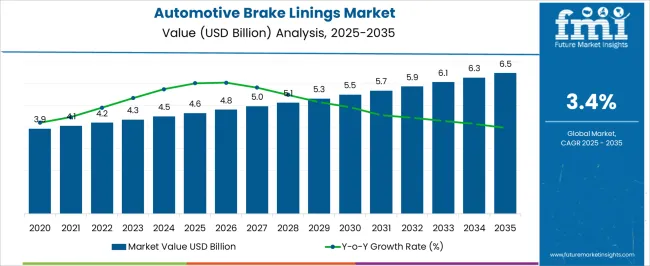
| Metric | Value |
|---|---|
| Automotive Brake Linings Market Estimated Value in (2025 E) | USD 4.6 billion |
| Automotive Brake Linings Market Forecast Value in (2035 F) | USD 6.5 billion |
| Forecast CAGR (2025 to 2035) | 3.4% |
The Automotive Brake Linings market is witnessing steady growth driven by increasing automotive production, rising vehicle ownership, and heightened focus on vehicle safety and performance standards. The market is largely influenced by the transition toward non-asbestos based brake linings due to environmental regulations and health considerations.
Demand is further shaped by the expansion of the automotive aftermarket, which allows vehicle owners to replace and upgrade brake components cost-effectively. Technological advancements in friction materials, coupled with enhanced braking performance requirements for passenger and commercial vehicles, are paving the way for broader adoption of advanced brake lining solutions.
Additionally, the shift toward lighter and more fuel-efficient vehicles has increased the need for high-performance materials capable of delivering durability and consistent braking under varying conditions As the global automotive sector continues to expand in both developed and emerging economies, the market for brake linings is expected to maintain robust growth, supported by continuous innovation and increasing replacement cycles driven by vehicle usage patterns.
The automotive brake linings market is segmented by vehicle type, material type, sales channel, and geographic regions. By vehicle type, automotive brake linings market is divided into Passenger Cars, Light Commercial Vehicles, Heavy Commercial Vehicles, and Electric Vehicles. In terms of material type, automotive brake linings market is classified into Non-Asbestos Based Automotive Brake Linings and Asbestos Based Automotive Brake Linings. Based on sales channel, automotive brake linings market is segmented into Aftermarket and Oem. Regionally, the automotive brake linings industry is classified into North America, Latin America, Western Europe, Eastern Europe, Balkan & Baltic Countries, Russia & Belarus, Central Asia, East Asia, South Asia & Pacific, and the Middle East & Africa.
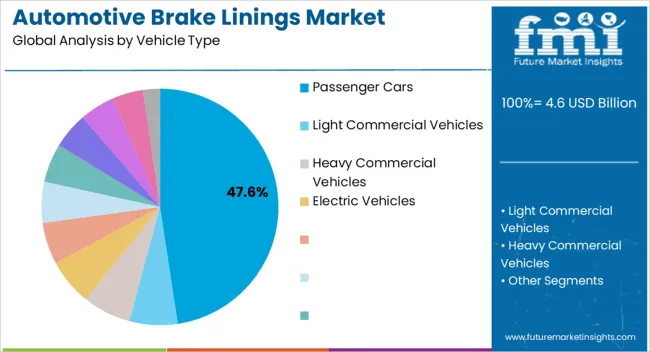
The passenger cars segment is projected to hold 47.60% of the Automotive Brake Linings market revenue in 2025, making it the leading vehicle type segment. This dominance is being driven by high global production and sales of passenger vehicles, which require reliable and durable braking systems for safety and performance. Passenger vehicles are increasingly equipped with advanced braking technologies, which has spurred demand for high-quality brake linings that provide consistent friction, long life, and low wear.
The growth of urbanization and rising disposable income in emerging markets has accelerated passenger vehicle ownership, further increasing replacement demand. Additionally, stringent safety regulations and emission standards have encouraged vehicle manufacturers and aftermarket players to adopt materials that improve performance while minimizing environmental impact.
The prevalence of passenger cars as the primary mode of personal transportation has solidified their contribution to overall brake lining consumption The segment’s continued growth is expected to be supported by vehicle fleet expansion and ongoing advancements in braking materials and vehicle safety technologies.
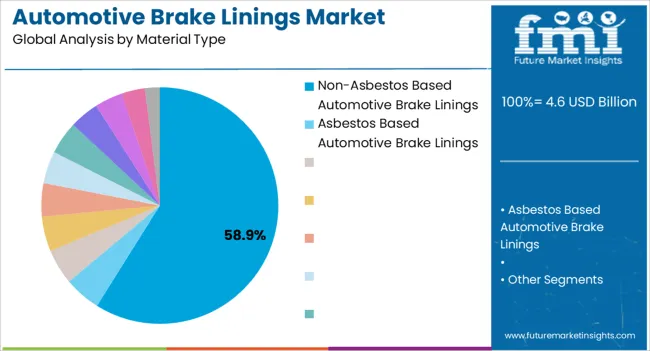
Non-asbestos based automotive brake linings are estimated to account for 58.90% of total market revenue in 2025, making this the leading material type segment. This growth is being driven by environmental and health regulations that have restricted the use of asbestos due to its carcinogenic properties. Non-asbestos formulations, including organic, semi-metallic, and ceramic materials, offer superior performance, durability, and reduced environmental impact.
Their adoption is further accelerated by increased awareness among manufacturers and consumers regarding sustainability and vehicle safety standards. These brake linings provide consistent friction performance, reduced noise, and less wear on rotors, which makes them preferable for both original equipment and replacement markets.
Technological developments in composite friction materials have enhanced braking efficiency, making non-asbestos linings increasingly compatible with modern vehicles that demand higher performance under diverse driving conditions As vehicle manufacturers continue to focus on environmentally friendly and high-performance components, non-asbestos brake linings are expected to maintain their leading position in the market.

The aftermarket segment is projected to hold 55.20% of the Automotive Brake Linings market revenue in 2025, making it the dominant sales channel. This leadership is being attributed to the growing need for vehicle maintenance and replacement of brake components over the vehicle life cycle.
Vehicle owners increasingly prefer aftermarket solutions due to their accessibility, cost-effectiveness, and variety of material options, which cater to performance, durability, and budget requirements. The aftermarket also benefits from extended vehicle longevity, rising used car sales, and an expanding network of service centers, which collectively boost demand for brake lining replacements.
Furthermore, advancements in non-asbestos friction materials have enhanced the attractiveness of aftermarket products, providing improved braking performance while complying with safety and environmental regulations The aftermarket segment continues to be preferred for both passenger cars and commercial vehicles, and as the global vehicle fleet expands, the demand for replacement brake linings through aftermarket channels is expected to sustain its growth trajectory.
An automotive brake lining is a layer of frictional material bonded to the brake shoes. The material used for the manufacture of automotive brake linings is heat resistant to prevent friction from causing sparks or fire. Automotive brake linings are made from soft although tough heat resistant materials and are mounted over the brake shoe using high temperature adhesives. Recent technological advancements have led to the development of advanced braking systems. The use of automotive brake linings prevents the wear and tear of other braking components.
With growing concerns towards safety and security and the need for enhanced performance efficiency of brake systems, there has been a rise in the demand from OEMs for advanced automotive brake linings. There has also been a rise in the demand for advanced braking systems to achieve improved braking capability and a pleasant braking sensation. Growing vehicle production and rising fleet on road are driving the demand for automotive brake linings, both in the OEM and aftermarket.
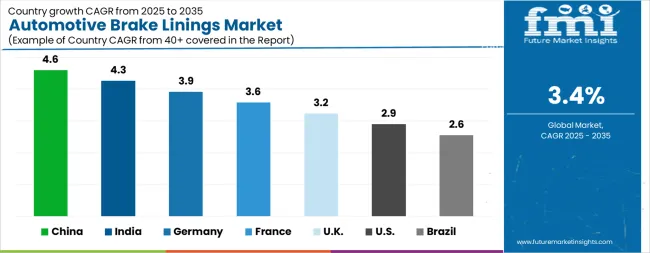
| Country | CAGR |
|---|---|
| China | 4.6% |
| India | 4.3% |
| Germany | 3.9% |
| France | 3.6% |
| UK | 3.2% |
| USA | 2.9% |
| Brazil | 2.6% |
The Automotive Brake Linings Market is expected to register a CAGR of 3.4% during the forecast period, exhibiting varied country level momentum. China leads with the highest CAGR of 4.6%, followed by India at 4.3%. Developed markets such as Germany, France, and the UK continue to expand steadily, while the USA is likely to grow at consistent rates. Brazil posts the lowest CAGR at 2.6%, yet still underscores a broadly positive trajectory for the global Automotive Brake Linings Market. In 2024, Germany held a dominant revenue in the Western Europe market and is expected to grow with a CAGR of 3.9%. The USA Automotive Brake Linings Market is estimated to be valued at USD 1.6 billion in 2025 and is anticipated to reach a valuation of USD 2.2 billion by 2035. Sales are projected to rise at a CAGR of 2.9% over the forecast period between 2025 and 2035. While Japan and South Korea markets are estimated to be valued at USD 247.0 million and USD 133.0 million respectively in 2025.
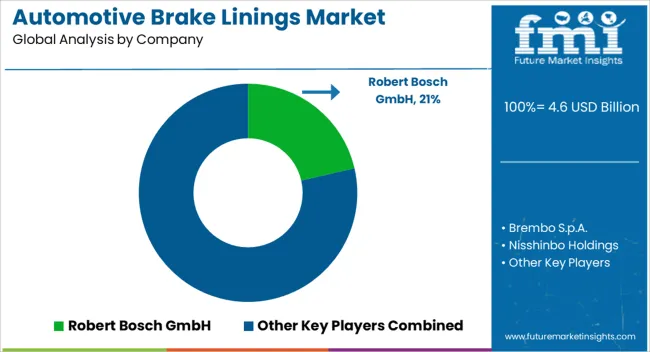
| Item | Value |
|---|---|
| Quantitative Units | USD 4.6 Billion |
| Vehicle Type | Passenger Cars, Light Commercial Vehicles, Heavy Commercial Vehicles, and Electric Vehicles |
| Material Type | Non-Asbestos Based Automotive Brake Linings and Asbestos Based Automotive Brake Linings |
| Sales Channel | Aftermarket and Oem |
| Regions Covered | North America, Europe, Asia-Pacific, Latin America, Middle East & Africa |
| Country Covered | United States, Canada, Germany, France, United Kingdom, China, Japan, India, Brazil, South Africa |
| Key Companies Profiled | Robert Bosch GmbH, Brembo S.p.A., Nisshinbo Holdings, Akebono Brake Industry, Federal-Mogul Motorparts (Tenneco), Aisin Corporation, TRW Automotive, and Mando Corporation |
The global automotive brake linings market is estimated to be valued at USD 4.6 billion in 2025.
The market size for the automotive brake linings market is projected to reach USD 6.5 billion by 2035.
The automotive brake linings market is expected to grow at a 3.4% CAGR between 2025 and 2035.
The key product types in automotive brake linings market are passenger cars, light commercial vehicles, heavy commercial vehicles and electric vehicles.
In terms of material type, non-asbestos based automotive brake linings segment to command 58.9% share in the automotive brake linings market in 2025.






Our Research Products

The "Full Research Suite" delivers actionable market intel, deep dives on markets or technologies, so clients act faster, cut risk, and unlock growth.

The Leaderboard benchmarks and ranks top vendors, classifying them as Established Leaders, Leading Challengers, or Disruptors & Challengers.

Locates where complements amplify value and substitutes erode it, forecasting net impact by horizon

We deliver granular, decision-grade intel: market sizing, 5-year forecasts, pricing, adoption, usage, revenue, and operational KPIs—plus competitor tracking, regulation, and value chains—across 60 countries broadly.

Spot the shifts before they hit your P&L. We track inflection points, adoption curves, pricing moves, and ecosystem plays to show where demand is heading, why it is changing, and what to do next across high-growth markets and disruptive tech

Real-time reads of user behavior. We track shifting priorities, perceptions of today’s and next-gen services, and provider experience, then pace how fast tech moves from trial to adoption, blending buyer, consumer, and channel inputs with social signals (#WhySwitch, #UX).

Partner with our analyst team to build a custom report designed around your business priorities. From analysing market trends to assessing competitors or crafting bespoke datasets, we tailor insights to your needs.
Supplier Intelligence
Discovery & Profiling
Capacity & Footprint
Performance & Risk
Compliance & Governance
Commercial Readiness
Who Supplies Whom
Scorecards & Shortlists
Playbooks & Docs
Category Intelligence
Definition & Scope
Demand & Use Cases
Cost Drivers
Market Structure
Supply Chain Map
Trade & Policy
Operating Norms
Deliverables
Buyer Intelligence
Account Basics
Spend & Scope
Procurement Model
Vendor Requirements
Terms & Policies
Entry Strategy
Pain Points & Triggers
Outputs
Pricing Analysis
Benchmarks
Trends
Should-Cost
Indexation
Landed Cost
Commercial Terms
Deliverables
Brand Analysis
Positioning & Value Prop
Share & Presence
Customer Evidence
Go-to-Market
Digital & Reputation
Compliance & Trust
KPIs & Gaps
Outputs
Full Research Suite comprises of:
Market outlook & trends analysis
Interviews & case studies
Strategic recommendations
Vendor profiles & capabilities analysis
5-year forecasts
8 regions and 60+ country-level data splits
Market segment data splits
12 months of continuous data updates
DELIVERED AS:
PDF EXCEL ONLINE
Automotive Direct Liquid Cooling IGBT Module Market Size and Share Forecast Outlook 2025 to 2035
Automotive Hoses and Assemblies Market Size and Share Forecast Outlook 2025 to 2035
Automotive Network Testing Market Size and Share Forecast Outlook 2025 to 2035
Automotive Performance Part Market Size and Share Forecast Outlook 2025 to 2035
Automotive Camshaft Market Size and Share Forecast Outlook 2025 to 2035
Automotive Stamping Industry Analysis in India Size and Share Forecast Outlook 2025 to 2035
Automotive Cylinder Liner Market Size and Share Forecast Outlook 2025 to 2035
Automotive Microcontroller Market Size and Share Forecast Outlook 2025 to 2035
Automotive Roof Rails Market Size and Share Forecast Outlook 2025 to 2035
Automotive Active Safety System Market Size and Share Forecast Outlook 2025 to 2035
Automotive Diagnostic Scan Tool Market Size and Share Forecast Outlook 2025 to 2035
Automotive Test Equipment Market Size and Share Forecast Outlook 2025 to 2035
Automotive Dynamic Map Data Market Size and Share Forecast Outlook 2025 to 2035
Automotive Green Tires Market Size and Share Forecast Outlook 2025 to 2035
Automotive E-Tailing Market Size and Share Forecast Outlook 2025 to 2035
Automotive Interior Market Forecast Outlook 2025 to 2035
Automotive Key Market Size and Share Forecast Outlook 2025 to 2035
Automotive Appearance Chemical Market Forecast and Outlook 2025 to 2035
Automotive Seating Market Forecast and Outlook 2025 to 2035
Automotive Domain Control Module Market Forecast and Outlook 2025 to 2035

Thank you!
You will receive an email from our Business Development Manager. Please be sure to check your SPAM/JUNK folder too.
Chat With
MaRIA